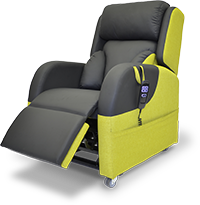As obesity becomes an ever-greater issue for caregivers across the UK, bariatric chairs are increasingly turned to as an invaluable seating asset. But what is a bariatric chair and, more specifically, how is it cleaned and maintained? Premiere Healthcare provides answers in this guide.
For the care system, the fact that a greater proportion of the British population is obese presents significant challenges. As patients are now taller and heavier than ever before, it’s important that they spend sufficient time out of bed, to avoid the problems of muscle wastage, decreased overall mobility and pressure on critical body areas.
Specialist design for larger patients
But ‘standard’ chairs are too small and fragile to manage the patients’ larger, heavier frames. Leading to the embarrassment of patients becoming stuck or, more importantly, further damage to their health. To overcome these problems, bariatric chairs are designed to cope with far heavier loads, some being able to cope with loads of 50 stone and more.
The support provided by a bariatric chair, such as those made by CareFlex, is unique in that it accommodates the larger gluteal shelf found in obese patients, which means traditional seating doesn’t give users the full back support they need. The danger of this is that they’re forced forward in the chair, and neither their legs or upper back are supported adequately, which can cause long-term postural problems. The specialist design of a bariatric chair means this is never an issue.
A regular activity
Cleaning and maintaining a bariatric chair is of utmost importance for both carer and patient. Of course, cleaning and regular maintenance of the chair should be carried out often and at well-regimented intervals, as with any specialised care equipment, to safeguard both the health of the patient and the overall sanitisation of the care environment.
And there are typically certain design features that can help – whether the patient is or isn’t seated at the time.
Very often, the bariatric chair will feature removable or fold-up armrests, for example, which can give the caregiver more space to put a sling in place, if the patient is able to be moved in this way. This is often accompanied by the ability to detach armrest covers, for more efficient cleaning. Other features such as tip-up seats can help too, making it easy to access the parts of the seat behind the patient.
Equally, the materials used in the construction of the bariatric chair should assist with cleaning and maintenance. Many feature vinyl upholstery, which is ideal for environments requiring quick wipe-clean processes. In other instances, where fabric upholstery is used, these are often waterproofed for hygienic cleaning.
Key cleaning considerations
In terms of the actual cleaning regime, certain considerations should be borne in mind.
- With the patient in situ, care must be taken not to put undue pressure on their back, arms and legs, so their individual mobility requirements should always be the carer’s first consideration.
- Mild detergent, mixed with warm water, should be used to wipe down any framework regularly. A more abrasive cleaner could damage the frame of the bariatric chair.
- For any upholstery, approved cleaning materials should only ever be used, with a deep clean (with the patient removed) being performed at regular intervals.
- To ensure complete hygiene, after cleaning, the carer should ensure that no residual water is left in the framework or in gaps between the framework and upholstery, as this can cause permanent damage – it’s often recommended that a bariatric chair is left unused for an hour or two after a clean to make sure all the moisture is gone.
These are, of course, only general guidance points. The specific requirements of your patients and your care environment will determine the precise cleaning and maintenance regime you will need to make the most of your bariatric chair(s).
So if you’d like more in-depth advice on choosing the right bariatric chair for users, please don’t hesitate to get in touch. We have assessors all over the country who can come out and do home visits free of charge, and bring some chairs along for your user(s) to try on the day.
To book an assessment or find out more, please contact us online or call us on 0345 521 1819.









